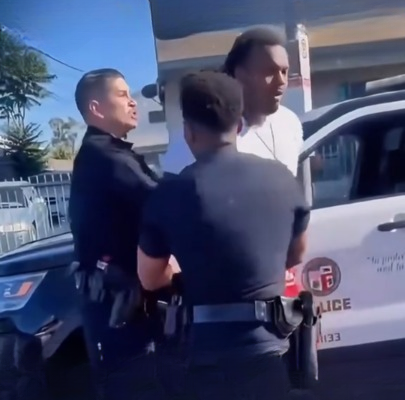Community Calls for Transparency After Controversial Arrest Sparks Nationwide Discussion
In recent days, a video circulated across several online platforms has prompted deep reflection, public concern, and a renewed call for transparency in law enforcement. The footage, which appears to show a police officer detaining a man who was already in handcuffs, has become the focal point of a nationwide conversation on accountability, justice, and community trust.While officials have confirmed that an internal investigation is underway, the broader public discourse goes far beyond the immediate event. Citizens, advocacy organizations, and legal experts are using this moment to emphasize the importance of fairness, procedural integrity, and the human need for reassurance that justice is both equal and impartial.
The Incident That Sparked the Debate
According to multiple eyewitnesses and statements released by local authorities, the event began as what seemed to be a routine arrest. The man involved was reportedly compliant and cooperative with officers throughout the interaction. Observers say he did not resist or pose any visible threat. However, the video—filmed by a bystander—appears to show an exchange that has raised questions about whether appropriate procedures were followed.Officials later confirmed that the man was unarmed at the time of the arrest. This detail has deepened the public’s demand for answers and has encouraged local leaders to reaffirm their commitment to reviewing the case thoroughly and transparently. The police department involved has acknowledged public concern and announced that body camera footage from the officers on the scene will be reviewed and, in time, released to the public as the investigation proceeds.
The Role of Social Media and Public Awareness
In today’s digital world, information travels faster than ever before. The moment the video was uploaded, it spread rapidly across social platforms, drawing millions of views and sparking heated but necessary discussions. Many viewers expressed sadness, frustration, or confusion over what they saw, while others urged patience and restraint, emphasizing that the full context is still being reviewed.
Social media plays a complex role in situations like this. On one hand, it allows communities to hold public institutions accountable and ensures that potential injustices do not go unnoticed. On the other, it can amplify emotion before facts are fully verified. Many community leaders and digital ethics experts have highlighted the importance of consuming such content responsibly, encouraging users to verify information before forming final judgments.
Calls for Calm and Constructive Action
Local officials, community organizers, and civil rights advocates have all urged for a measured response. Rather than letting anger dominate the conversation, they emphasize the importance of channeling collective concern into constructive advocacy. The focus, they say, should remain on ensuring fairness in the investigative process and promoting long-term improvements in police-community relations.
Civil rights groups have called for the suspension of the officer involved pending the outcome of the inquiry, a move they believe would demonstrate the department’s commitment to impartiality. However, law enforcement representatives have also reminded the public that due process applies to all individuals, including officers, and that every case must be evaluated on factual evidence.
The Importance of Accountability
Accountability remains one of the most discussed topics in the wake of this event. Advocates argue that transparency in such investigations not only upholds public trust but also protects officers who act according to protocol. Releasing body camera footage, sharing updates on the status of internal reviews, and providing clear communication are steps that departments can take to demonstrate commitment to ethical policing.
Over the past decade, many law enforcement agencies have taken proactive steps to improve training and oversight mechanisms. Initiatives focused on de-escalation tactics, bias awareness, and communication strategies are becoming increasingly standard. However, advocates note that consistent implementation is essential for progress to be meaningful.
Historical Context: Why These Conversations Matter
Incidents involving law enforcement and communities of color have long drawn national attention in the United States. Each new report or video tends to reopen broader social wounds, forcing both citizens and institutions to reckon with difficult historical realities. Scholars who study race and justice say that while awareness has improved, the work of achieving true equality under the law remains ongoing.
The current situation has reignited discussions around equitable treatment, emphasizing that every citizen—regardless of race, background, or social status—deserves to be treated with dignity and respect during all encounters with authorities. That belief lies at the core of both the nation’s legal framework and its moral conscience.
Statements from Officials and Investigators
Local authorities have confirmed that the department’s internal affairs division has opened an official investigation into the matter. A public spokesperson for the department stated that transparency is a top priority and that findings will be released once the review is complete.
The statement also emphasized that the department recognizes the emotional impact this video has had on the community and understands why many residents are upset. “We take these concerns very seriously,” the spokesperson said, “and we are committed to determining exactly what happened.”
Community leaders have praised this acknowledgment but continue to press for clear timelines and open communication. Transparency, they argue, is not just about releasing documents or footage—it’s about demonstrating that public institutions truly serve the people they are sworn to protect.
Community Voices: Hope, Concern, and Resolve
Throughout the city, residents have gathered for peaceful discussions and community forums. These events have been characterized by thoughtful dialogue rather than confrontation, reflecting a collective desire for clarity and understanding. Participants have expressed a wide range of emotions—from pain to hope—but all seem united in wanting lasting solutions rather than short-term outrage.
Several community members have also pointed out the importance of distinguishing between individuals and entire institutions. They stress that accountability must be specific and based on verified actions, not generalized assumptions about entire professions. This balanced perspective helps sustain mutual respect while still demanding justice where wrongdoing occurs.
Media Responsibility and Ethical Reporting
The way such stories are reported also plays a major role in shaping public perception. Responsible journalism aims to inform without inflaming, to question without condemning prematurely, and to prioritize facts over speculation. Major news outlets covering this story have largely adhered to these principles, emphasizing verified details while waiting for official reports before drawing conclusions.
Ethical media coverage helps ensure that justice is pursued based on truth rather than rumor. By maintaining balance, journalists can contribute to solutions that bring communities together instead of deepening divides.
The Broader Question: How Can Trust Be Rebuilt?
Trust between communities and law enforcement is one of the cornerstones of a functioning democracy. When that trust is shaken, it affects not only the people directly involved but also the entire social fabric. Experts in criminal justice reform emphasize that trust can be rebuilt through consistent transparency, open communication, and shared commitment to fairness.
Initiatives such as citizen review boards, public reporting of disciplinary outcomes, and enhanced community outreach programs are among the measures many cities have adopted to strengthen relationships between residents and police. When implemented effectively, these tools can prevent small misunderstandings from escalating into widespread mistrust.
Education and Awareness as Long-Term Solutions
Beyond investigations and official reviews, many community organizations are focusing on education. Workshops, seminars, and dialogue circles provide spaces for citizens and officers to learn from one another’s perspectives. Understanding cultural differences, implicit biases, and emotional triggers can make real encounters safer and more respectful for everyone involved.
Schools and youth programs also play a powerful role in shaping the next generation’s understanding of civic responsibility and justice. Teaching young people how to engage constructively with public institutions fosters a more informed and empathetic society—one that values fairness over division.
The Role of Policy Reform
Policy reform remains central to ongoing efforts for systemic improvement. Advocates for change are calling for updated use-of-force guidelines, greater oversight of misconduct complaints, and more transparent public reporting systems. Policymakers are also exploring the potential of independent investigation units—separate from police departments—to handle allegations of excessive force or misconduct.
While no single reform can solve every issue, experts agree that consistent, evidence-based policymaking is key to progress. Policies rooted in fairness, equality, and accountability help ensure that justice remains both impartial and visible.
The Human Impact
Beyond the headlines and official statements, this story is deeply human. It involves individuals—both the person who was detained and the officer who made the arrest—whose lives have been profoundly affected by a moment that unfolded in seconds.
For the man involved, community members have expressed compassion and concern, wishing for his physical and emotional recovery. For the officer, the investigation will determine whether his actions were within the bounds of proper conduct. Either way, both individuals are part of a broader system that must continually evaluate its standards and expectations.
The families on both sides deserve empathy and fairness as the process continues. A justice system functions best when it upholds both accountability and compassion.
Public Reflection and Moving Forward
Moments like these often serve as turning points—opportunities for society to reflect, learn, and grow. Whether one views this incident as an isolated error or part of a larger pattern, it undeniably highlights the need for continual dialogue and reform.
Citizens can use this moment to engage in community-building rather than division. Peaceful advocacy, civic participation, and informed discussion are all vital tools in shaping a more equitable future.
Many observers hope that the outcome of this investigation will not only clarify the facts of this case but also reinforce a long-term commitment to fairness, equality, and transparency in all public institutions.
Conclusion: The Path Toward a Just Society
As the investigation proceeds, patience and vigilance will both be essential. Justice must be thorough, evidence-based, and free from bias. For communities watching closely, this moment is a reminder that the pursuit of fairness never truly ends—it requires sustained attention, empathy, and dialogue.
The video that began this national discussion may have revealed discomforting questions, but it has also reignited a collective commitment to ensuring that every individual—regardless of race, background, or circumstance—can trust in equal treatment under the law.
Ultimately, the hope shared by millions is that such moments lead not to deeper division, but to a renewed sense of shared responsibility—a belief that justice, when pursued with transparency and compassion, can be the foundation of unity rather than conflict.



